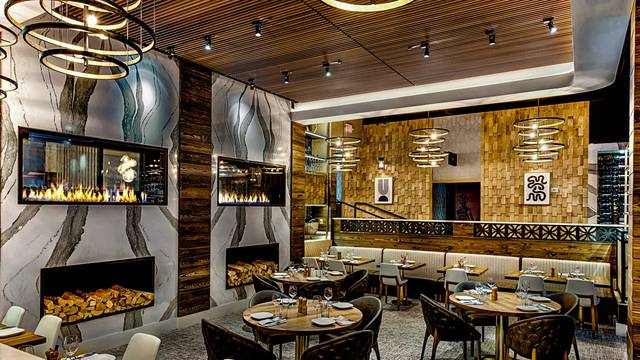Savor Genuine Oriental Cuisine With a Pan-Asian Spin for a Cooking Journey
Beginning on a culinary trip via authentic Asian cuisine, enhanced with a Pan-Asian spin, offers an one-of-a-kind possibility to discover the abundant tapestry of tastes that define the region's varied culinary practices. This experience welcomes you to relish the beautiful balance of preferences-- sweet, salted, spicy, and sour-- integrated by fragrant herbs and flavors. Think of the ingenious combination of Thai curry and ramen or the unforeseen pleasure of sushi burritos. As you consider these tempting meals, consider the cultural stories and historic influences that shape them, each bite supplying a tale waiting to be found.

Discovering Pan-Asian Flavors
In the realm of international gastronomy, Pan-Asian cuisine sticks out for its remarkable variety and the harmonious interaction of flavors from different Eastern societies. This culinary technique celebrates the rich practices and distinct active ingredients discovered across the continent, developing a tapestry of preferences that is both rewarding and appealing. Key to Pan-Asian food is its ability to balance different flavors-- pleasant, salty, spicy, and sour-- while highlighting the freshness and high quality of each component.
From the umami-rich soy sauce of Japan to the fiery chili peppers of Thailand, Pan-Asian food uses a substantial scheme of tastes. These elements are typically combined in inventive means, boosting dishes with layers of complexity. For example, the usage of great smelling herbs such as lemongrass and cilantro, usual in Vietnamese and Thai cuisine, adds a rejuvenating illumination to dishes, while the consolidation of coconut milk delivers a velvety, abundant texture.
The focus on fresh produce and aromatic spices guarantees that each meal is not only a feast for the taste but likewise for the senses. Pan-Asian food welcomes restaurants to get started on a culinary journey, exploring the huge and varied landscapes of Oriental gastronomy with every bite.
Fusion Dishes to Attempt
While Pan-Asian cuisine is commemorated for its standard flavors, the modern-day culinary landscape is significantly accepting fusion meals that blend these traditional components with influences from various other regions. This innovative strategy not just honors the rich heritage of Eastern cookeries however likewise introduces unique preference experiences that interest modern palates.
A prime example of such a combination recipe is the Korean-Mexican taco, where marinated bulgogi beef is wrapped in a cozy tortilla, covered with kimchi and a hot gochujang-infused salsa. This mix marries the bold, full-flavored tastes of Korea with the vibrant, fresh elements of Mexican cuisine. Similarly, sushi burritos have gained popularity, integrating the delicate creativity of Japanese sushi with the hearty, hand-held benefit of a burrito, frequently featuring combination active ingredients like tempura shrimp and avocado with a drizzle of wasabi mayo.
One more significant meal is Thai curry ramen, which instills the velvety, aromatic spices of Thai curry right into the reassuring brew of conventional Japanese ramen, producing a harmonious blend that tantalizes the senses. These combination recipes expand past plain uniqueness; they represent a culinary discussion between cultures, urging exploration and advancement worldwide of Pan-Asian food.
Important Ingredients and Flavors
To absolutely value Pan-Asian food, one must recognize the important ingredients and flavors that develop its structure. This varied cooking design draws from an click this site abundant tapestry of Asian traditions, employing an unified blend of textures and tastes. Key components include soy sauce, fish sauce, and oyster sauce, which pass on a full-flavored umami deepness important to Oriental dishes. Complementary to these are rice vinegar and mirin, offering a delicate level of acidity and sweet taste.
Aromatic aspects are crucial, with lemongrass, ginger, and garlic being common across numerous Pan-Asian dishes. These active ingredients offer an aromatic base that enhances the intricacy of flavors. Seasonings such as star anise, cardamom, and cinnamon present warmth and personality, echoing impacts from regions like China and India.

Cooking Strategies and Tips
Understanding the art of Pan-Asian food needs familiarity with its unique cooking techniques, each adding to the vibrant tapestry of tastes this culinary practice is commemorated for. Central to these approaches is the stir-fry, a fast food preparation technique that protects the nutritional integrity and vibrant shades of active ingredients. Making use of a wok, the stir-fry technique allows for even warmth distribution, crucial for achieving the characteristic structure and taste equilibrium of Pan-Asian meals.
One more basic method is steaming, especially common in Chinese cuisine. This gentle technique preserves the natural tastes and nutrients of components, making it ideal for fish and shellfish and veggies. Dumplings, a cherished staple, commonly take advantage of steaming, resulting in soft, delicious textures.
Grilling, also integral, imparts smoky midsts to dishes such as Korean bulgogi or Japanese yakitori (pan asian dining Islamabad). This method commonly involves marinading components, enabling tastes to permeate deeply prior to cooking over an open flame or warmer
Last but not least, understanding the art of balancing tastes-- wonderful, sour, salted, bitter, and umami-- is important. Appropriately layering these aspects can elevate a dish from average to phenomenal, offering a complicated and satisfying cooking experience that embodies the essence of Pan-Asian cuisine.
Eating Experiences Worldwide
Around the world, Pan-Asian food provides an unequaled eating experience, celebrated for its abundant tapestry of tastes and vivid discussions. This culinary sensation has actually gone beyond social borders, recording the hearts and tastes buds of food fanatics worldwide. In multicultural cities fresh York, London, and Sydney, Pan-Asian dining establishments act as fusions where culinary customs from Thailand, Japan, China, and beyond converge, offering restaurants with a diverse mix of dishes that highlight the area's variety.
The worldwide allure of Pan-Asian food lies in its capability to use both credibility and advancement. Cooks skillfully wed traditional ingredients such as view website lemongrass, soy sauce, and miso with lunch places near me contemporary methods, causing recipes that are both familiar and refreshingly new. This combination permits diners to begin on a cooking journey that respects heritage while welcoming modernity.
In addition, dining experiences are elevated through thoughtfully made atmospheres that reflect the values of Pan-Asian visual appeals. From minimalist Japanese-inspired insides to dynamic Thai-themed rooms, each restaurant provides an one-of-a-kind setting that matches the culinary offerings. Consequently, patrons are not just taking in a meal but partaking in a cultural experience, making Pan-Asian dining a really worldwide sensation.
Verdict
The expedition of Pan-Asian food supplies an extensive understanding of the complex interaction of tastes and culinary practices across Asia. By welcoming fusion dishes such as Thai curry ramen and sushi burritos, the culinary journey not only highlights the flexibility of traditional active ingredients yet also showcases cutting-edge modern-day techniques. This gastronomic journey, enhanced by cooking methods and important spices, provides an one-of-a-kind opportunity to appreciate the multiculturalism and culinary creativity that specify Pan-Asian food on a worldwide scale.
Embarking on a cooking trip through genuine Eastern cuisine, boosted with a Pan-Asian twist, offers a special chance to explore the rich tapestry of flavors that specify the region's varied culinary customs.In the world of global gastronomy, Pan-Asian cuisine stands out for its exceptional variety and the unified interaction of flavors from numerous Asian societies. Key to Pan-Asian cuisine is its capability to balance contrasting tastes-- pleasant, salted, spicy, and sour-- while highlighting the quality and high quality of each ingredient.
